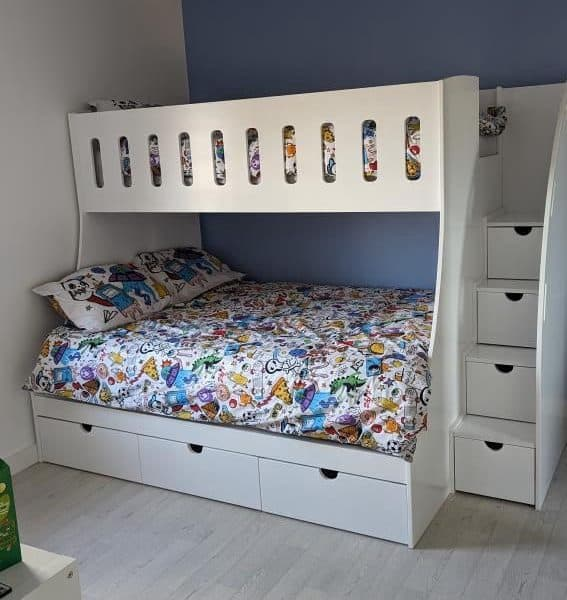In today’s world, maximizing space in a home is essential, especially in urban settings where square footage comes at a premium. One innovative solution to this problem is the double bed and single bunk combo. This setup not only saves space but also provides a versatile sleeping arrangement suitable for various living situations.
Whether you are a growing family, have frequent guests, or are looking to make the most out of a small room, this guide will help you understand the benefits, design considerations, and practical tips for implementing a double bed and single bunk combo in your home.
Understanding the Double Bed and Single Bunk Combo
A double bed and single bunk combo typically features a double bed on the bottom with a single bunk bed overhead. This configuration is often referred to as a twin-over-full bunk bed. A double bed with a single bunk is designed to accommodate more sleepers in the same footprint as a traditional bunk bed, making it an excellent choice for maximizing space in small rooms.
Benefits of a Double Bed and Single Bunk Combo
There are numerous advantages to using a double bed and single bunk combo:
- Space Efficiency: By stacking sleeping areas vertically, you free up floor space that can be used for other purposes, such as play areas, study desks, or additional storage.
- Versatility: This setup is suitable for various occupants, from children to adults, making it perfect for guest rooms, children’s rooms, or shared bedrooms.
- Cost-Effective: Investing in a double bed and single bunk combo can be more economical than purchasing separate beds and additional furniture to accommodate multiple sleepers.
- Aesthetic Appeal: Modern designs offer stylish and attractive options that can complement any interior decor.
Choosing the Right Double Bed and Single Bunk Combo
When selecting a double bed and single bunk combo, several factors need to be considered to ensure it meets your needs and preferences.
Material and Durability
The material of the bunk bed significantly impacts its durability and longevity. Common materials include:
- Wood: Solid wood bunk beds are sturdy and offer a classic look. They can be heavier but provide excellent stability and durability.
- Metal: Metal bunk beds are lightweight and often come in contemporary designs. They are usually easier to assemble and move but might not offer the same warmth as wooden options.
- Composite Materials: These are often a mix of wood and other materials, providing a balance between durability and cost.
Safety Features
Safety is paramount, especially if the bunk bed will be used by children. Key safety features to look for include:
- Guardrails: Ensure the top bunk has secure guardrails on all sides to prevent falls.
- Ladder Stability: The ladder should be sturdy and easy to climb, with non-slip steps if possible.
- Weight Capacity: Check the weight limits for both the upper and lower bunks to ensure they can safely support the intended users.
Size and Dimensions
Measure your room carefully to determine the maximum size of the bunk bed that will fit comfortably. Consider the height of the room as well, ensuring there is enough clearance for the top bunk. Standard dimensions for a twin-over-full bunk bed are approximately 80 inches in length, 60 inches in width, and 65 inches in height, but these can vary by design.
Design and Aesthetics
Bunk beds come in a variety of styles, from traditional to modern. Consider the overall aesthetic of your room and choose a bunk bed that complements your decor. Options include:
- Traditional: Often made of wood with classic lines and details.
- Modern: Sleek designs, often in metal or a combination of materials, with minimalist lines.
- Themed: Bunk beds are designed for children with fun themes like castles, treehouses, or sports.
Installation and Assembly Tips
Proper installation and assembly are crucial for the safety and functionality of your double bed and single bunk combo.
Preparing the Room
Before assembling the bunk bed, ensure the room is ready:
- Clear the Space: Remove any obstacles and ensure there is enough room to move around during assembly.
- Check for Level Floors: Make sure the floor is level where you plan to place the bed. Uneven floors can lead to instability.
Tools and Equipment
Gather all necessary tools and equipment before starting the assembly. Common tools include:
- Screwdrivers (flathead and Phillips)
- Allen wrenches (often included with the bed)
- Rubber mallet (for gently adjusting parts)
- Tape measure
- Level
Assembly Steps
Follow the manufacturer’s instructions carefully. General steps include:
- Sort the Parts: Lay out all parts and hardware, checking against the parts list to ensure nothing is missing.
- Assemble the Frame: Start with the main frame, typically the bottom bed. Ensure all bolts and screws are tightened securely.
- Attach the Ladder and Guardrails: Install the ladder and guardrails according to the instructions. Ensure they are secure and stable.
- Install the Top Bunk: Carefully place and secure the top bunk, making sure all connections are tight and stable.
- Final Checks: Double-check all connections and ensure the bed is stable and level.
Maximizing Space and Functionality
To fully capitalize on the space-saving benefits of a double bed and single bunk combo, consider additional strategies for maximizing space and functionality.
Under-Bed Storage
Utilize the space under the bottom bed for storage. Options include:
- Drawers: Some bunk beds come with built-in drawers or trundle beds.
- Storage Bins: Use plastic or fabric bins to store items like toys, clothes, or bedding.
- Rolling Carts: Low-profile rolling carts can be an excellent way to store and access items easily.
Multi-Functional Furniture
Incorporate other multi-functional furniture pieces to enhance the room’s usability:
- Foldable Desks: Wall-mounted or foldable desks can provide a study area without taking up permanent floor space.
- Convertible Furniture: Look for furniture that serves multiple purposes, such as a sofa bed or an ottoman with storage.
Organizational Tips
Keep the room organized to make the most of the available space:
- Vertical Storage: Use wall-mounted shelves, hooks, and organizers to keep items off the floor.
- Declutter Regularly: Regularly go through belongings and remove items that are no longer needed.
- Label Storage Bins: Label bins and drawers to make it easy to find and put away items.
Design Ideas and Inspirations
Designing a room with a double bed and single bunk combo can be a fun and creative process. Here are some design ideas to inspire you.
Children’s Room Themes
Incorporate themes that spark imagination and make the room enjoyable for children:
- Adventure Theme: Decorate with maps, globes, and explorer gear. Add a tent or canopy over the bottom bed to create a cozy hideaway.
- Under the Sea: Use blue and green tones with sea creature decals. Consider a bunk bed that resembles a ship or submarine.
- Space Exploration: Starry night decals, astronaut bedding, and space-themed accessories can make the room out of this world.
Guest Room Elegance
For a guest room, aim for a sophisticated and welcoming atmosphere:
- Neutral Colors: Use a neutral color palette with soft textures to create a calming environment.
- Luxurious Bedding: Invest in high-quality bedding for both the double bed and the single bunk to ensure comfort.
- Functional Furniture: Include a small desk or vanity, and provide plenty of storage for guests’ belongings.
Modern Minimalism
Create a sleek and modern look with minimalist design principles:
- Monochromatic Palette: Stick to a monochromatic color scheme with varying shades of one color.
- Clean Lines: Choose a bunk bed with clean lines and minimalistic features.
- Functional Decor: Use decor that is both functional and stylish, such as geometric shelves or sleek lighting.
Safety and Maintenance
Maintaining the safety and condition of your double bed and single bunk combo is essential for long-term use.
Regular Inspections
Perform regular inspections to ensure the bed remains safe and sturdy:
- Check Connections: Periodically check all screws, bolts, and connections to ensure they are tight and secure.
- Inspect Guardrails: Ensure the guardrails are firmly attached and in good condition.
- Examine the Ladder: Make sure the ladder is stable and the steps are not worn or damaged.
Cleaning and Care
Proper cleaning and care can extend the life of your bunk bed:
- Dust Regularly: Dust the bed frame regularly to prevent buildup.
- Spot Clean: For wood frames, use a damp cloth to spot clean any spills or stains. Avoid harsh chemicals that can damage the finish.
- Protect Mattresses: Use mattress protectors to keep the mattresses clean and free from allergens.
Weight Limits and Usage
Adhere to the manufacturer’s weight limits and usage guidelines:
- Upper Bunk Limit: Ensure that the weight on the upper bunk does not exceed the recommended limit.
- Even Distribution: Encourage even distribution of weight on the bottom bed to prevent sagging or damage.
- Proper Use: Educate children on safe usage, such as no jumping on the beds and using the ladder properly.
Making the Most of a Small Space
Living in a small space requires creativity and efficient use of every square inch. Here are some additional tips to make the most of your room with a double bed and single bunk combo.
Light and Color
Use light and color to create an illusion of space:
- Light Colors: Light-colored walls and furniture can make a room feel larger and more open.
- Natural Light: Maximize natural light by keeping windows unobstructed and using light, airy curtains.
- Mirrors: Strategically place mirrors to reflect light and create a sense of depth.
Smart Storage Solutions
Incorporate smart storage solutions to keep the room organized and clutter-free:
- Built-In Shelves: Use built-in shelves to save floor space and provide ample storage.
- Hidden Storage: Opt for furniture with hidden storage compartments, such as ottomans, benches, or bed frames with storage drawers.
- Multi-Level Shelving: Use multi-level shelving units to take advantage of vertical space.
Flexible Layouts
Create a flexible room layout that can adapt to changing needs:
- Modular Furniture: Use modular furniture that can be rearranged easily to suit different purposes.
- Open Floor Plan: Keep the floor plan open and avoid heavy, bulky furniture that can make the room feel cramped.
- Zoning: Create distinct zones for different activities, such as sleeping, studying, and playing, to maintain a sense of order and purpose.
Conclusion
A double bed and single bunk combo is an excellent solution for maximizing space in small rooms while providing versatile sleeping arrangements. By carefully considering factors such as material, safety features, size, and design, you can choose the perfect bunk bed to suit your needs.
Additionally, incorporating smart storage solutions, flexible layouts, and thoughtful design elements can enhance the functionality and aesthetic appeal of your space. With the right approach, you can create a comfortable, organized, and stylish room that makes the most of every square inch.
Stay in touch to get more updates & new discovertribune.org!




